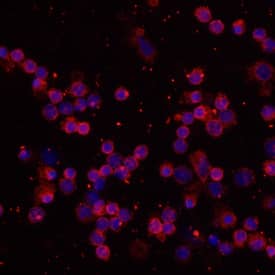Human CAMP/LL37/FALL39 Antibody Summary
Leu134-Ser170
Accession # P49913
Customers also Viewed
Applications
Please Note: Optimal dilutions should be determined by each laboratory for each application. General Protocols are available in the Technical Information section on our website.
Scientific Data
 View Larger
View Larger
Detection of Human CAMP/LL37/FALL39 by Western Blot. Western blot shows lysates of human peripheral blood mononuclear cells (PBMC). PVDF membrane was probed with 1 µg/mL of Sheep Anti-Human CAMP/LL37/FALL39 Antigen Affinity-purified Polyclonal Antibody (Catalog # AF7497) followed by HRP-conjugated Anti-Sheep IgG Secondary Antibody (Catalog # HAF016). A specific band was detected for CAMP at approximately 18 kDa (as indicated). This experiment was conducted under reducing conditions and using Immunoblot Buffer Group 1.
Preparation and Storage
- 12 months from date of receipt, -20 to -70 °C as supplied.
- 1 month, 2 to 8 °C under sterile conditions after reconstitution.
- 6 months, -20 to -70 °C under sterile conditions after reconstitution.
Background: CAMP/LL37/FALL39
CAMP (Cathelicidin AntiMicrobial Peptide; also18 kDa cationic antimicrobial protein, CAP18, LL37, FALL39 and HSD26) is a member of the cathelicidin family of proteins. It is widely expressed, being found associated with neutrophils, bronchial epithelium, renal tubule epithelium, activated keratinocytes, gamma δ T cells, monocytes, NK cells, colonic epithelium and the stratum basale of nonkeratinized epithelium found in the vagina and oral cavity. CAMP has marked antimicrobial activity against both Gm+ and Gm- bacteria, and acts as a chemoattractant for neutrophils, monocytes and mast cells. CAMP is synthesized as 170 amino acid (aa) preproprecursor. It contains a 30 aa signal sequence, a 103 aa, 14 kDa prosegment (aa 31-131), and a 4-5 kDa, 37 aa (aa 134-170) C‑terminal mature fragment (LL37) or 39 aa (aa 132‑170) C‑terminal mature fragment (FALL39). In neutrophils, the 18-19 kDa proprecursor is stored in granules, where, upon activation, it is enzymatically cleaved and released. While both the prosegment and C‑terminal fragments possess antimicrobial activity, the prosegment also shows antiprotease activity, while the C‑terminal fragment also shows chemotactic activity. The prosegment may form homodimers, while the C‑terminal fragment (LL37) is reported to form homotetramers. Over aa 141-170, human CAMP shares only 50% and 57% aa sequence identity with mouse and rat CAMP, respectively.
Product Datasheets
Citation for Human CAMP/LL37/FALL39 Antibody
R&D Systems personnel manually curate a database that contains references using R&D Systems products. The data collected includes not only links to publications in PubMed, but also provides information about sample types, species, and experimental conditions.
1 Citation: Showing 1 - 1
-
Human serum triggers antibiotic tolerance in Staphylococcus aureus
Authors: EVK Ledger, S Mesnage, AM Edwards
Nature Communications, 2022-04-19;13(1):2041.
Species: Human
Sample Types: Serum
Applications: Neutralization
FAQs
No product specific FAQs exist for this product, however you may
View all Antibody FAQsIsotype Controls
Reconstitution Buffers
Secondary Antibodies
Reviews for Human CAMP/LL37/FALL39 Antibody
There are currently no reviews for this product. Be the first to review Human CAMP/LL37/FALL39 Antibody and earn rewards!
Have you used Human CAMP/LL37/FALL39 Antibody?
Submit a review and receive an Amazon gift card.
$25/€18/£15/$25CAN/¥75 Yuan/¥2500 Yen for a review with an image
$10/€7/£6/$10 CAD/¥70 Yuan/¥1110 Yen for a review without an image









